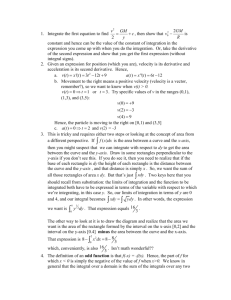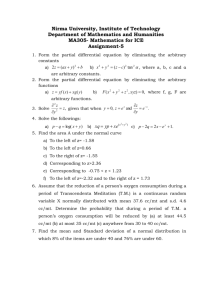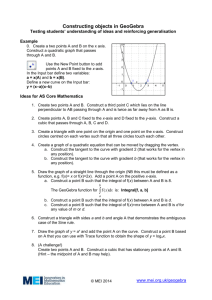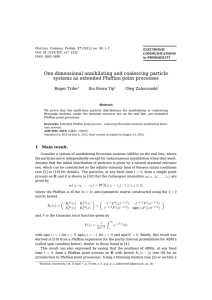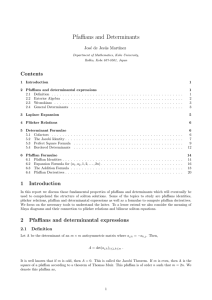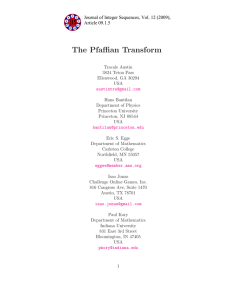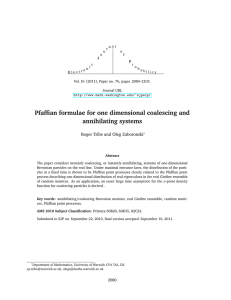MATH443 PARTIAL DIFFERENTIAL EQUATIONS FIRST MIDTERM
advertisement
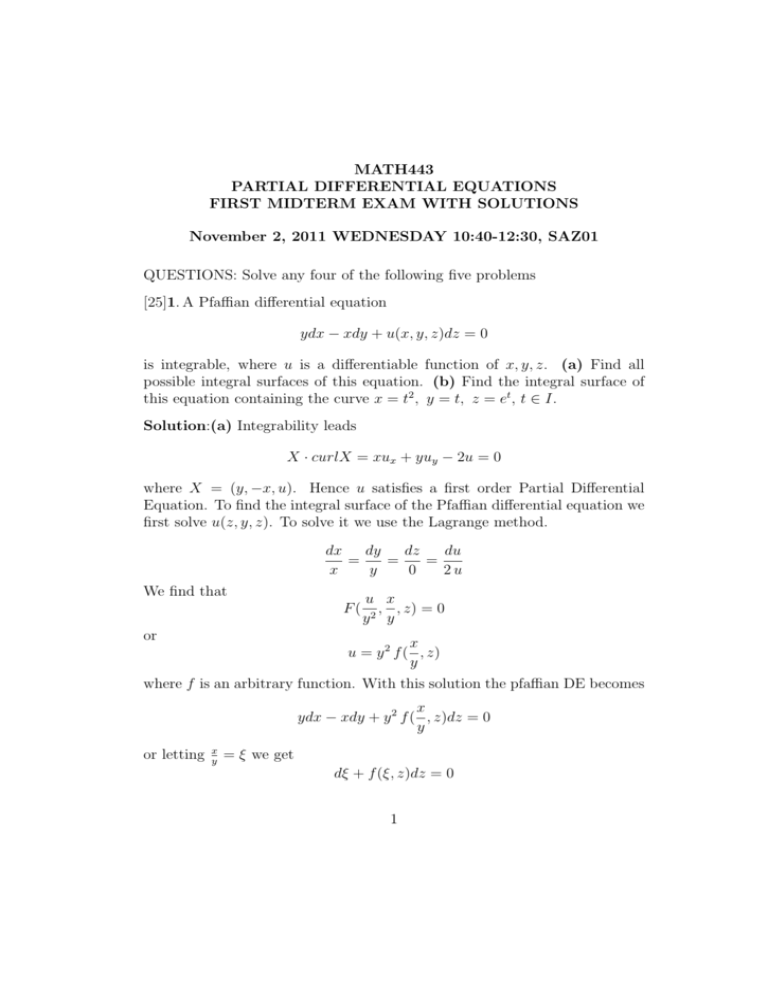
MATH443 PARTIAL DIFFERENTIAL EQUATIONS FIRST MIDTERM EXAM WITH SOLUTIONS November 2, 2011 WEDNESDAY 10:40-12:30, SAZ01 QUESTIONS: Solve any four of the following five problems [25]1. A Pfaffian differential equation ydx − xdy + u(x, y, z)dz = 0 is integrable, where u is a differentiable function of x, y, z. (a) Find all possible integral surfaces of this equation. (b) Find the integral surface of this equation containing the curve x = t2 , y = t, z = et , t ∈ I. Solution:(a) Integrability leads X · curlX = xux + yuy − 2u = 0 where X = (y, −x, u). Hence u satisfies a first order Partial Differential Equation. To find the integral surface of the Pfaffian differential equation we first solve u(z, y, z). To solve it we use the Lagrange method. dy dz du dx = = = x y 0 2u We find that F( or u x , , z) = 0 y2 y x u = y 2 f ( , z) y where f is an arbitrary function. With this solution the pfaffian DE becomes x ydx − xdy + y 2 f ( , z)dz = 0 y or letting x y = ξ we get dξ + f (ξ, z)dz = 0 1 Let the integrating factor be φ(ξ, z). Then φ(dξ + f dz) = dψ which means that psi(ξ, z) = c where c is an arbitrary constant and φ = ψξ , φf = ψz or f= ψz ψξ Without loosing generality we can let ψ = h(ξ) − z, then f =− 1 h0 (ξ) and the family of integral surfaces is x z = h( ) y where h is an arbitrary function. (b). If an integral surface contains the curve C : x = t2 , y = t, z = et we get h(t) = et Then the solution is x z = ey [25]2. (a) Find all possible surfaces orthogonal to the planes x + 2y + cz = 1, where c is an arbitrary real constant.(b) Find the surfaces orthogonal to the planes x + 2y + cz = 1 passing through the curve z(x, x) = x2 . Solution: (a) Normal vector (1, 2, c) of the plane is orthogonal to the surface S with normal (p, q, −1). Then we get p + 2q − c = 0 This is a linear first order pde. We solve it by using the Lagrange method. The solution is z = c x + f (y − 2x) 2 where f is an arbitrary function. Hence the family surfaces (level surfaces) z = c x + f (y − 2x) is orthogonal to the pale x + 2y + cz = 1. (b) Among this orthogonal family one contains the curve C : x = t, y = t, z = t2 . Hence t2 = ct + f (−t) or f (t) = t2 + c t then the solution is z = cx + (y − 2x)2 + c (y − 2x) = c(y − x) + (y − 2x)2 [25]3. Verify that the equation z(z + y 2 )dx + z(z + x2 )dy − xy(x + y)dz = 0 is integrable and find its primitive. Solution: (a) This pfaffian differential equation is integrable, i.e., X = (z(z + x2 ), z(z + y 2 ), −xy(x + y)) and X · curlX = 0. (b) To solve it e use the Natani’s method. First let z be fixed. We find x+y = c(z) (1) z − xy Then let x = 1 we find y(z + 1) =a z(y + 1) (2) where a is a constant. Let x = 1 in (1) we get 1+y = c(z) z−y Solving y from (2) we get y = zc−1 1+c and inserting it in (3) we get c(z) = 1 1 a−1 z Hence the solution (the primitive)is F (x, y, z) = z(x + y) =b z − xy 3 (3) where b = 1 a−1 is an arbitrary constant [25]4. Find the integral surface of the equation (x + y − z)p − (y + x + z)q = 2z. (4) passing through the curve z(x, x) = 1. Solution: We use the Lagrange method to solve this problem dx dy dz =− = x+y =z x+y+z 2z which has solutions u = x + y + z = c1 , x+y+z v=y+ ln z = c2 2 (5) (6) The integral surface contains the curve C : x = t, y − t.z = 1, then we find 2c2 − c1 + 1 = 0 or y − x − z + 1 + (x + y + z) ln z = −0 [25]5. Find a complete integral of the equation p2 y(1 + x2 ) − q x2 = 0. Solution: We solve such problems firs finding a solution of the set of equations dy dz dp dq dx = = =− =− fp fq pfp + qfq fx + pfz fy + qfz 4 Where f = p2 y(1 + x2 ) − q x2 = 0. Using first and fourth terms we get x2 p2 = a2 1+x 2 and q = ay. Then √ ax dz = √ dx + aydy 1 + x2 The solution is √ √ a a 1 + x2 + y 2 + b 2 where a ≥ 0 and b are arbitrary constants. If we consider the second and fifth terms we get the same solutions again. z= 5


